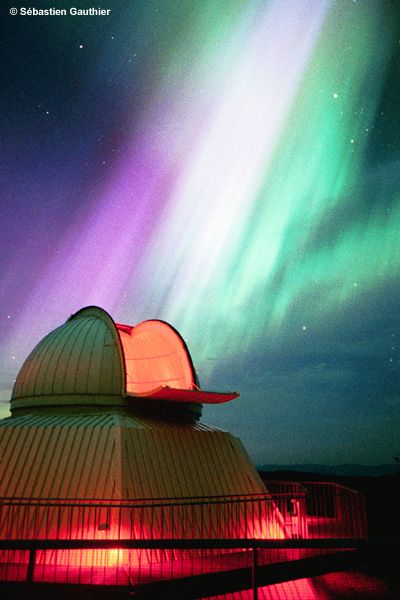Explanation: Plasma from the Sun and debris from a comet both collided with planet Earth last Saturday morning triggering magnetic storms and a meteor shower in a dazzling atmospheric spectacle. The debris stream from comet Swift-Tuttle is anticipated yearly, and many skygazers already planned to watch the peak of the annual Perseids meteor shower in the dark hours of August 11/12. But the simultaneous, widely reported auroras were triggered by the chance arrival of something much less predictable -- a solar coronal mass ejection. This massive bubble of energetic plasma was seen leaving the active Sun's surface on August 9, just in time to travel to Earth and disrupt the planet's magnetic field triggering extensive auroras during the meteor shower's peak! Inspired by the cosmic light show, Sebastien Gauthier photographed the colorful auroral displays above the dramatic dome of the Mount-Megantic Popular Observatory in southern Quebec, Canada. Bright Jupiter and giant star Aldebaran can be seen peering through the shimmering northern lights at the upper right.
1999 2000 2001 2002 2003 2004 2005 2006 2007 2008 2009 2010 2011 2012 2013 2014 2015 2016 2017 2018 2019 2020 2021 2022 2023 2024 2025 |
Yanvar' Fevral' Mart Aprel' Mai Iyun' Iyul' Avgust Sentyabr' Oktyabr' Noyabr' Dekabr' |
NASA Web Site Statements, Warnings, and Disclaimers
NASA Official: Jay Norris. Specific rights apply.
A service of: LHEA at NASA / GSFC
& Michigan Tech. U.
|
Publikacii s klyuchevymi slovami:
aurora - polyarnoe siyanie - Meteornyi potok - storm - coronal mass ejection - Perseids - Perseidy - teleskop - koronal'nyi vybros - telescope
Publikacii so slovami: aurora - polyarnoe siyanie - Meteornyi potok - storm - coronal mass ejection - Perseids - Perseidy - teleskop - koronal'nyi vybros - telescope | |
Sm. takzhe:
Vse publikacii na tu zhe temu >> | |
